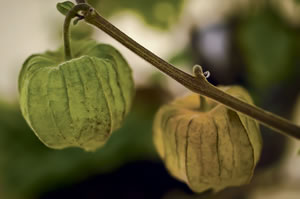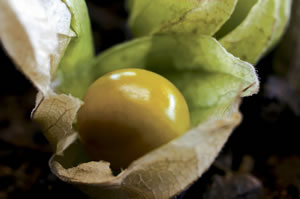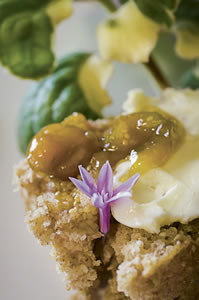Popping Perfect Poha Berries
Lelan Nishek started Kaua’i Nursery and Landscaping (KNL) 34 years ago. The one-man operation grew into a 150-acre property with close to 80 employees (before the downturn in the economy, there were 150 employees).From anthuriums and orchids to plumerias and palms, KNL sells hundreds of tropical plants and trees. Vegetable starts are from seeds obtained by the University of Hawaii that are disease-resistant and acclimated to Hawai’i.
The property includes a green-waste facility that shreds plant material and turns it into compost. Free weekend workshops are available, and topics include banana, citrus, breadfruit and bamboo.
Some edible varieties: Bananas, eggplant (green and long purple), herbs (unique and common), kale, lettuce, Okinawan spinach, pineapple guava, taro and tomatoes. Trees include avocado, bamboo, breadfruit, cinnamon, citrus, durian, jack fruit, mangosteen, pomegranate, sour sop.
POHA BERRIES
Native to the high altitudes of tropical Peru, Colombia and Ecuador, the fruit grows well in subtropical regions. Early settlers at the Cape of Good Hope, South Africa, planted the berries, which were then introduced to Australia, New Zealand and the Pacific Islands.
Also known as ground cherries, Cape gooseberries, Inca berry and Aztec berry, poha berries are an annual herbaceous plant, and rare on Kaua’i.“When my dad went to the Big Island,” says Sandy Nishek, “someone was selling them in a container. He brought it back, and we ate most of them, but we did propagate some, too.”
Poha berries are propagated from seed, and the fruit contains many. The berries are in the tomato family, and have a papery husk, similar to a tomatillo. Inside the husks (which can be used in dry flower decorations) is a fruit the size of a cherry. The soft flesh smells like a tomato, and when ripe it’s sweet, with floral undertones.
Season: Poha plants grow quickly, taking four to six months to go from seed to fruit, and will produce fruit three to four times a year. Once they reach maturity (green berries the size of a large marble), poha berries will take up to two weeks to ripen. Plants can live up to five years.
What to look for: When the tough, green husks change to papery, cream-colored ones, open the husk and take a peek. Ripe berries are gold in color. In rainy weather, the fruit is not picked until the plants are dry. Berries that are already wet need to be lightly dried in the sun.
Storage: If the berries are inside the husks, spread in a single layer and left at room temperature, they will last about 30 to 45 days.Preparation: Poha berries are addictive and best eaten raw. Just pop them into your mouth, like a cherry tomato. You can add them to salsas and salads. They pair well with avocado and strawberry, and make an excellent jam, but do not have enough pectin to make a decent jelly. They can be cooked and used in pies, strudels and bread pudding.
Tip: Remove plants from container, and plant like you would a tomato. The vining plant can grow up to 3 feet high, but supported it can grow up to 6 feet. Once plants fruit, prune them back one or two nodes from each main branch.
They will flush out again, and go into another cycle.
Health benefits: One cup of poha berries contains 74 calories, 2.66 grams of protein and 13 milligrams of calcium. Vitamin A, C and niacin are the most plentiful nutrients, and one cup will provide a quarter of the recommended daily allowance of vitamin C for adults. Several scientific studies demonstrate anti-inflammatory and antioxidant properties in poha berries. In South Africa, the heated leaves are applied as poultices on inflammations. In Colombia, some tribes use a leaf tea for asthma. The antispasmodic and muscle contractive properties may explain its widespread use for asthma.
Poha berry plants can be found at: Kaua’i Nursery and Landscaping, 3-1550 Kaumualii Hwy., Lihu’e. For more information, call 245-7747 or visit kauainursery.com. Plants are sold in 1-gallon pots for $4.50. Workshops are listed on the website.POHA BERRY JAM
Sandy makes poha berry jam and spreads it on fresh baked bread. She also adds a dollop to tender slices of roast pork, which is delicious! Her jam recipe calls for three pounds of berries, which can be hard to come by, so I’ve included a recipe that is made by the cup.
* Poha berries
* sugar
* water
Add fresh berries to a sauce pan with 2 tablespoons of water. Add 2 tablespoons of sugar per cup of berries. The berries will release a lot of water, so cook over medium heat until the mixture reaches a jam-like consistency. Store leftover jam in the refrigerator for up to two weeks.







